
Radcliffe College was a women's liberal arts college in Cambridge, Massachusetts that was founded in 1879. In 1999, it was fully incorporated into Harvard College.

Harvard College is the undergraduate college of Harvard University, a private Ivy League research university in Cambridge, Massachusetts, United States. Part of the Faculty of Arts and Sciences, Harvard College is Harvard University's traditional undergraduate program, offering AB and SB degrees. It is highly selective, with fewer than four percent of applicants being offered admission as of 2022.

The Harvard Crimson is the student newspaper of Harvard University and was founded in 1873. Run entirely by Harvard College undergraduates, it served for many years as the only daily newspaper in Cambridge, Massachusetts.

Harvard Yard, in Cambridge, Massachusetts, is the oldest part of the Harvard University campus, its historic center and modern crossroads. It contains most of the freshman dormitories, Harvard's most important libraries, Memorial Church, several classroom and departmental buildings, and the offices of senior University officials including the President of Harvard University.

The Signet Society of Harvard University was founded in 1870 by members of the class of 1871. The first president was Charles Joseph Bonaparte. It was, at first, dedicated to the production of literary work only, going so far as to exclude debate and even theatrical productions. According to The Harvard book
It seemed to the founders that there was room in the College world for another association that should devote itself more exclusively to literary work than is possible with large numbers. Accordingly, they confined the membership to a few, and required that new members shall be, so far as possible, "representative men," and that at least five should be in the first half of their class.

The Harvard University Science Center is Harvard's main classroom and laboratory building for undergraduate science and mathematics, in addition to housing numerous other facilities and services. Located just north of Harvard Yard, the Science Center was built in 1972 and opened in 1973 after a design by Josep Lluís Sert.

Pforzheimer House, nicknamed PfoHo (FOE-hoe) and formerly named North House, is one of twelve undergraduate residential Houses at Harvard University. It was named in 1995 for Carol K. and Carl Howard Pforzheimer Jr, major University and Radcliffe College benefactors, and their family.
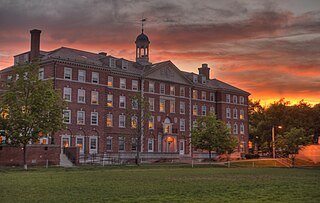
Cabot House is one of twelve undergraduate residential Houses at Harvard University. Cabot House derives from the merger in 1970 of Radcliffe College's South and East House, which took the name South House, until the name was changed and the House reincorporated in 1984 to honor Harvard benefactors Thomas Cabot and Virginia Cabot. The house is composed of six buildings surrounding Radcliffe Quadrangle; in order of construction, they are Bertram Hall (1901), Eliot Hall (1906), Whitman Hall (1911), Barnard Hall (1912), Briggs Hall (1923), and Cabot Hall (1937). All six of these structures were originally women-only Radcliffe College dormitories until they were integrated in 1970. Along with Currier House and Pforzheimer House, Cabot is part of the Radcliffe Quad.

Adams House is one of twelve undergraduate residential Houses at Harvard University, located between Harvard Square and the Charles River in Cambridge, Massachusetts. Its name commemorates the services of the Adams family, including John Adams, the second president of the United States, and John Quincy Adams, the sixth president.

President's House is a historic house at 17 Quincy Street, on the campus of Harvard University in Cambridge, Massachusetts. Built and paid for by the Lowell family, it served as a residence for Harvard Presidents until 1971, when Derek Bok (1971-1991) moved his family to Elmwood, another Lowell family property. In 1995, the building was renamed, and is currently known as Loeb House.

Memorial Hall, immediately north of Harvard Yard in Cambridge, Massachusetts, is an imposing High Victorian Gothic building honoring Harvard men's sacrifices in defense of the Union during the American Civil War—"a symbol of Boston's commitment to the Unionist cause and the abolitionist movement in America."
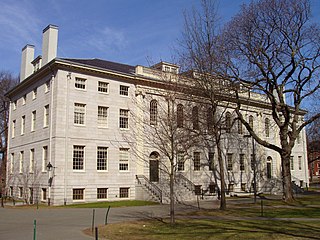
University Hall is a white granite building designed by the great early American architect Charles Bulfinch and built by the noted early engineer Loammi Baldwin, Jr. It is located in Harvard Yard on the campus of Harvard University in Cambridge, Massachusetts. It was designated a National Historic Landmark in 1970 for its architectural significance.

The Treadwell-Sparks House is an historic house at 21 Kirkland Street in Cambridge, Massachusetts. Built in 1838, it is a good local example of Greek Revival architecture, further notable as the home of historian Jared Sparks. Now owned by Harvard University, it was moved to its present location in 1968, and is used for professor housing. The house was listed on the National Register of Historic Places in 1986.

Quincy House is one of twelve undergraduate residential Houses at Harvard University, located on Plympton Street between Harvard Yard and the Charles River. The second largest of the twelve undergraduate houses, Quincy House was named after Josiah Quincy III (1772–1864), president of Harvard from 1829 to 1845. Quincy House's official counterpart at Yale University is Branford College.

John Harvard is a sculpture in bronze by Daniel Chester French in Harvard Yard, Cambridge, Massachusetts, honoring clergyman John Harvard (1607–1638), whose deathbed bequest to the "schoale or Colledge" recently undertaken by the Massachusetts Bay Colony was so gratefully received that it was consequently ordered "that the Colledge agreed upon formerly to bee built at Cambridg shalbee called Harvard Colledge." There being nothing to indicate what John Harvard had looked like, French used a Harvard student collaterally descended from an early Harvard president as inspiration.
The Franklin Delano Roosevelt Foundation is a private 501(c)3 US public charity based at Adams House, Harvard University. Founded as the FDR Suite Foundation in 2008, its original goal was to restore the Harvard rooms of Franklin Roosevelt, the 32nd President of the United States. The Foundation adopted its current name in 2014 to better reflect its broadened philanthropic mission to promote and preserve the legacy of Franklin Roosevelt throughout the world. The Foundation currently comprises three principal initiatives:
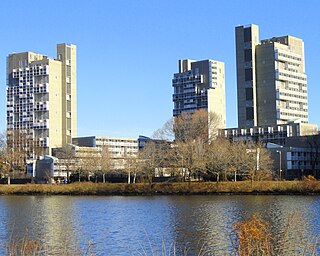
Peabody Terrace, on the north bank of the Charles River in Cambridge, Massachusetts, is a Harvard University housing complex primarily serving graduate students, particularly married students and their families. Designed in the brutalist style and constructed in 1964, its three-story perimeter grows to five and seven stories within, with three interior 22-story towers.
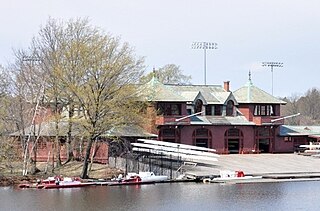
Newell Boathouse, named for a popular Harvard athlete killed just a few years after graduation, is the primary boathouse used by Harvard University's varsity men's rowing teams. It stands on land subject to an unusual peppercorn lease agreement between Harvard and the Commonwealth of Massachusetts.

Griswold Hall, built in 1967 according to a design by Benjamin Thompson Associates, is a Harvard Law School building housing faculty offices, the dean's office, and a classroom. According to Bainbridge Bunting, Griswold Hall and nearby Roscoe Pound Hall together "constitute the most adroit example of design for a given environment produced at Harvard since World War II, an achievement that equals Charles Coolidge's best work of the 1920s."
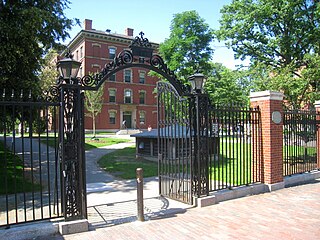
Bradstreet Gate, on the perimeter of Harvard Yard in Cambridge, Massachusetts, is a wrought-iron gate opposite Memorial Hall. In 1997 it was dedicated to Anne Bradstreet on the 25th anniversary of female students living in Harvard's freshman dormitories. A plaque with a quote from one of Bradstreet's poems was added in 2003.





















